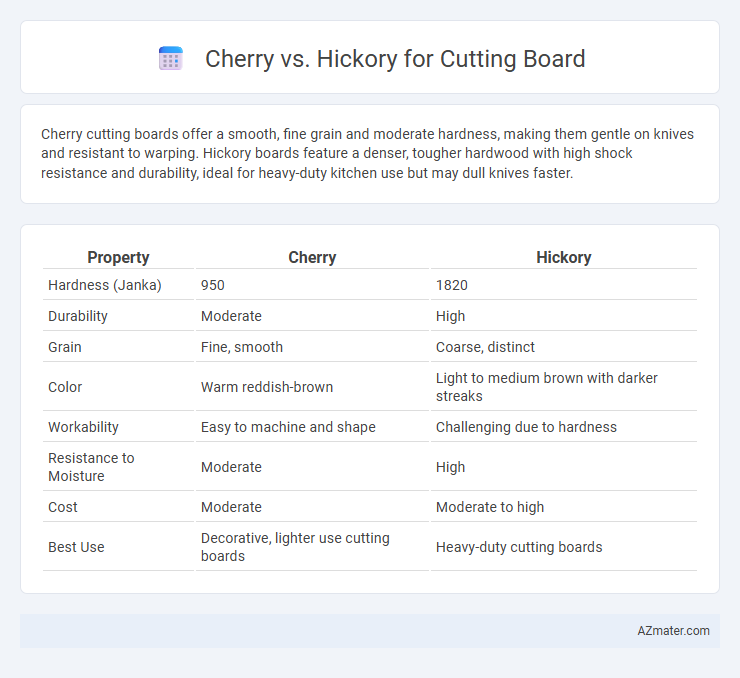Cherry cutting boards offer a smooth, fine grain and moderate hardness, making them gentle on knives and resistant to warping. Hickory boards feature a denser, tougher hardwood with high shock resistance and durability, ideal for heavy-duty kitchen use but may dull knives faster.
Table of Comparison
| Property | Cherry | Hickory |
|---|---|---|
| Hardness (Janka) | 950 | 1820 |
| Durability | Moderate | High |
| Grain | Fine, smooth | Coarse, distinct |
| Color | Warm reddish-brown | Light to medium brown with darker streaks |
| Workability | Easy to machine and shape | Challenging due to hardness |
| Resistance to Moisture | Moderate | High |
| Cost | Moderate | Moderate to high |
| Best Use | Decorative, lighter use cutting boards | Heavy-duty cutting boards |
Introduction: Cherry vs Hickory Cutting Boards
Cherry cutting boards feature a smooth, fine grain and rich reddish-brown color that darkens beautifully with age, offering excellent durability for everyday kitchen use. Hickory boards are known for their robust hardness and distinctive, contrasting grain patterns, providing superior resistance to knife marks and wear over time. Choosing between cherry and hickory cutting boards depends on balancing aesthetic preferences with the desired level of hardness and long-term maintenance needs.
Wood Hardness and Durability Comparison
Cherry wood rates around 2.5 on the Janka hardness scale, providing moderate hardness ideal for gentle cutting tasks, while Hickory scores significantly higher at approximately 3.8, indicating superior resistance to dents and scratches. The enhanced durability of Hickory makes it more suitable for heavy-duty use, ensuring a longer lifespan under frequent knife impact compared to the softer, more prone-to-nicking Cherry surface. Users seeking a balance between aesthetics and performance may prefer Cherry, but those prioritizing longevity and toughness should opt for Hickory cutting boards.
Grain Pattern and Aesthetics
Cherry cutting boards showcase a fine, closed grain that develops a rich, reddish-brown patina over time, enhancing their warm and elegant appearance. Hickory features a more pronounced, contrasting grain with light and dark streaks, offering a rustic, bold aesthetic that highlights natural wood variations. Both woods provide durability, but the choice depends on whether a subtle, refined look or a striking, dynamic pattern is preferred for kitchen use.
Knife Friendliness: Which Protects Blades Better?
Cherry cutting boards offer a moderately soft surface that is gentle on knife blades, minimizing dulling and maintaining edge sharpness over time. Hickory, being a hardwood with a higher Janka hardness rating, provides greater durability but can be tougher on knives, potentially causing faster blade wear. For optimal knife protection paired with durability, cherry is often preferred by chefs who prioritize blade longevity during frequent cutting tasks.
Maintenance and Care Requirements
Cherry cutting boards require moderate maintenance, needing regular oiling to prevent drying and cracking, with periodic sanding to remove knife marks and maintain a smooth surface. Hickory boards demand slightly more frequent conditioning due to their dense, coarse grain, which can absorb moisture and potentially warp if not properly cared for; they benefit from thorough drying after each use to avoid bacterial growth. Both woods should be cleaned with mild soap and water, dried immediately, and treated with food-safe mineral oil or board cream to extend their lifespan and preserve natural antibacterial properties.
Longevity and Resistance to Wear
Cherry cutting boards offer moderate longevity with a smooth surface that resists knife marks but can show wear over time due to its softer wood grain. Hickory cutting boards provide superior durability and resistance to wear, thanks to their dense, hard grain, making them ideal for heavy kitchen use and prolonged lifespan. Both woods require regular maintenance, but hickory's sturdiness ensures better performance against scratches and dents compared to cherry.
Food Safety and Antimicrobial Properties
Cherry wood offers natural antimicrobial properties that help inhibit bacterial growth, making it a safe and hygienic option for cutting boards. Hickory is also durable and dense, but it lacks the same level of antimicrobial compounds found in cherry, potentially requiring more rigorous cleaning to maintain food safety. Both woods are hardwoods favored for kitchen use, yet cherry's superior resistance to moisture and bacteria makes it preferable for maintaining a sanitary cutting surface.
Cost and Availability
Cherry cutting boards typically cost more than hickory due to their rich color and fine grain, making them a popular choice in higher-end markets. Hickory is generally more affordable and widely available, as it is a common hardwood in North America known for its durability and toughness. Availability of cherry can be limited in some regions, while hickory boards are easier to find in both local stores and online retailers.
Environmental Impact and Sustainability
Cherry wood cutting boards are often favored for their renewable nature and relatively fast growth rates, contributing to lower environmental impact compared to slower-growing hickory. Hickory trees, known for their dense and durable wood, require longer maturation periods, which can increase the sustainability concerns related to deforestation and habitat disruption. Both woods are biodegradable and recyclable, but sourcing cherry from certified sustainable forests ensures a more eco-friendly choice for cutting board production.
Which Cutting Board Should You Choose?
Cherry cutting boards offer a smooth, fine-grain surface that is gentle on knives and develops a rich, warm patina over time, making them ideal for aesthetic appeal and durability. Hickory boards are harder and more resistant to deep cuts and scratches, providing superior durability for heavy use but may dull knives faster due to their density. Choosing between cherry and hickory depends on your preference for knife-friendliness versus toughness and the level of maintenance you are willing to perform.

Infographic: Cherry vs Hickory for Cutting Board
 azmater.com
azmater.com